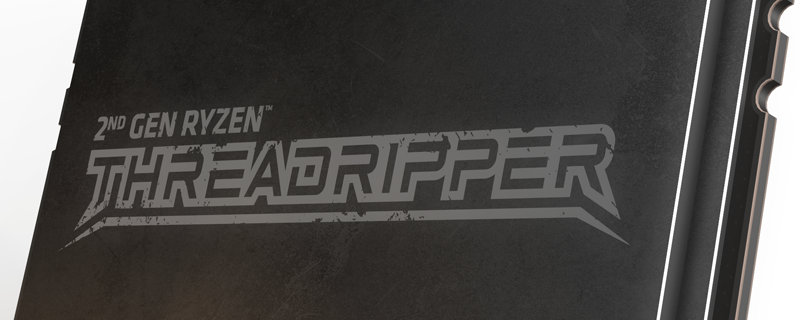AMD Threadripper 2950X and 2990WX Review
Introduction
We have spoken at length about the way in which the Ryzen CPU range has totally revitalised AMD. For a long time they have been a company which provides affordable setups with clear upgrade paths thanks to their adherence to utilising the same CPU socket for as long as possible.
With the Zen architecture and its attendant Ryzen CPUs AMD moved from affordable to affordable and also spectacular. The launch of the Threadripper 1950X – a 16 core CPU at a significantly lower price point than the Intel equivalent – was the feather in this particular cap. If you are the type of user who renders either videos or 3D content then you’ll know that these tasks are the equivalent of the linen necessary to get a good nights sleep; high thread counts are a must.
The 2nd Generation Ryzen CPUs smoothed out what few rough spots existed with the Ryzen processors and this refinement enhanced an already attractive product range. It was only a matter of time before AMD took a look at their flagship model and applied their refinements to it, and sure enough they have. Not only do we have a 2nd Generation Threadripper 2950X to replace the 1950X, but there are some new, even more insane, processors to attract the power users.
Technical Specifications
Of the four new CPUs that have the Threadripper name we’re looking at the two main candidates today. The Threadripper 2950X is the updated version of the Threadripper 1950X, whilst at the top end there is a new flagship in the form of the 32 core, 64 thread Threadripper 2990WX. 32 cores for flips sake. Most of us are still making do with four cores and waiting a week for our gameplay videos to render. So what is new about these 2nd Generation Threadripper CPUs?
One area that has seen a significant improvement is memory latency and speed. L3 cache has seen the most significant drop, down 15%, whilst L2 cache and L3 cache are a hair under 10% more responsive than they were on the originals. DDR4 latency has also seen a minor drop whilst the new Ryzen supports DDR4-2933, 266 MHz faster than the original. It isn’t only the memory that has improved as a refinement of the 12nm process allows for higher overclocking, around 200 MHz better boost, whilst also coming with around a 100mV core voltage reduction. So it’s more efficient, faster and has lower latency.
The Ryzen Threadripper 2950X is generally aimed at those with a serious split between their time creating and their time gaming, whilst the 2990WX is very much aimed at those who create nearly all the time and only have light gaming. The modern lazy coding style of gaming companies means that a lot of big software houses aren’t expecting home users to have this many cores at their disposal so a lot of games just haven’t a clue what to do when the answer to “how many cores has this system” returns a number that starts with a 3. This is partly related to the internal design of the Threadripper 2990WX. Utilising four 8 core dies tied together with AMDs Infinity Fabric, two of them have access to the PCI Express lanes and memory channels, whilst the other two are purely there to number crunch. The 2950X conversely has both dies able to access the full set of IO functions.
| Â | AMD Ryzen Threadripper 2950X | AMD Ryzen Threadripper 2990WX |
| TDP | 180W | 250W |
| Core Count | 16 Cores, 32 Threads | 32 Cores, 64 Threads |
|
Core Topology |
8 cores in 2 dies | 8 cores in 4 dies |
| L2 Cache | 512K per core (8MB) | 512K per core (16MB) |
| L3 Cache | 16MB per die (32MB) | 16MB per die (64MB) |
| Base Frequency | 3.5 GHz | 3 GHz |
| Boost Frequency | 4.4 GHz | 4.2 GHz |
| PCI Gen3 Lanes | 64 | 64 |
| Memory Channels | Quad | Quad |
| XFR2 | Enabled | Enabled |
| Precision Boost 2 | Enabled | Enabled |
| Transistor Count | 9.6 billion | 19.2 billion |
| Die Size | 2x 213mm2 | 4x 213mm2 |
An area that has improved in a manner more readily apparent to the average user is the upgrade to the Precision Boost. One element it struggled with on the original was scenarios in which there was a high number of threads being utilised, but not utilised to their fullest. Now with the updated Precision Boost 2 it is more aware of the total loading and then can use any thermal and power headroom to increase the clock speed a little further by monitoring the CPU state every millisecond and adjust the clock speed as necessary. Additionally Precision Boost might have a prescribed set of boost clocks available to it, but it doesn’t take into account those of us who have committed to cooling our CPU as efficiently as possible. That is where the updated Extended Frequency Range 2 (XFR2) comes into play, able to adjust all cores and threads dependant upon the thermal environment, instead of the original which had a limited number of cores available to tweak.
Let’s have a look at the availability and pricing before showing you them in the flesh and then the all important benchmarks.



